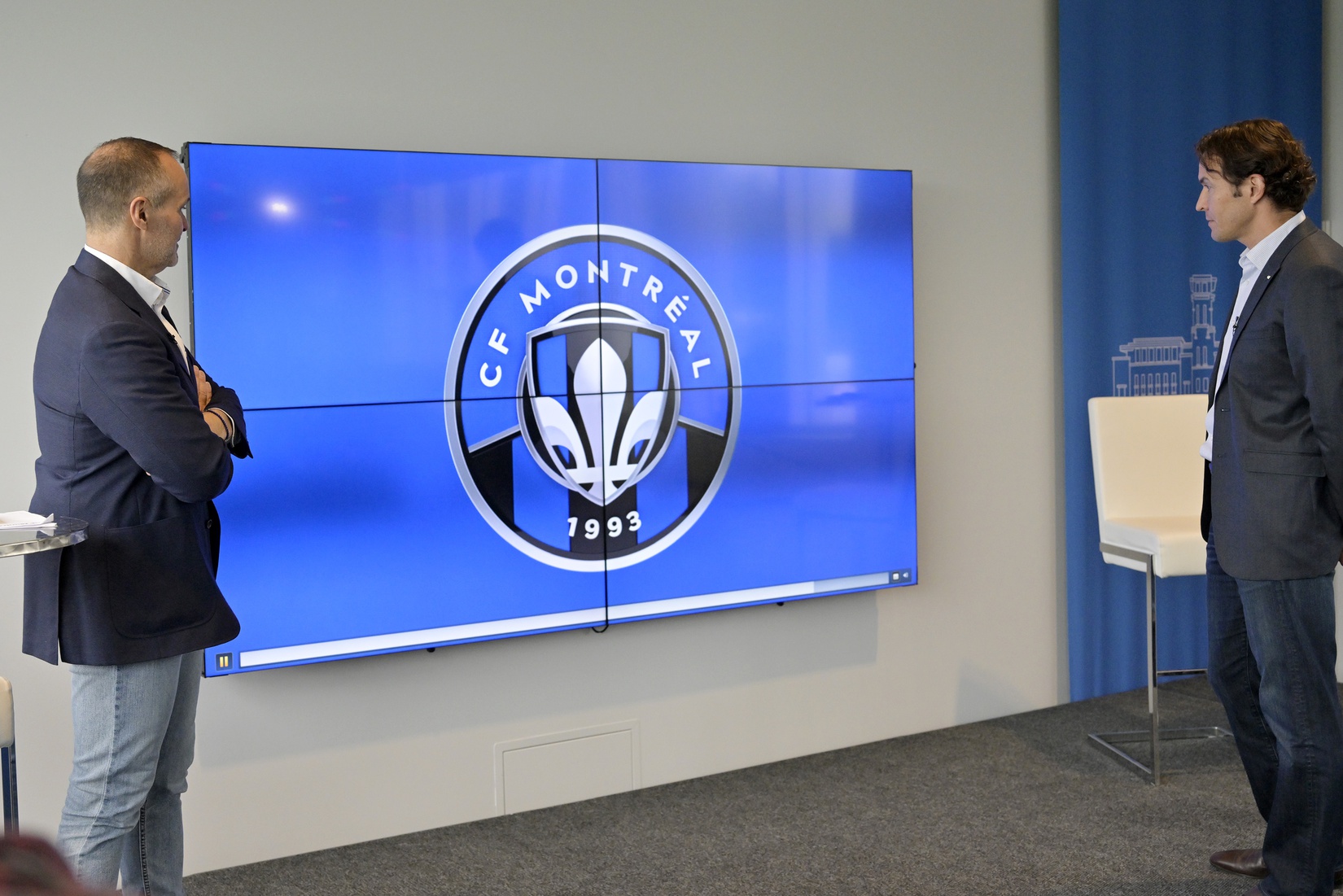CF Montréal (full name: Club de Foot Montréal), one of only three Canadian MLS teams, had its name recently changed from what was previously known as the Montreal Impact. The team came in as a 2012 MLS Expansion team and 2024 will be the 13th MLS season for the club.
The Origins of the CF Montréal Name
Then CF Montréal team president, Kevin Gilmore, explained why the name change was made, as he believed in modernizing the brand of “CF Montréal.” Here were his reasons for it (source: Daniel J. Rowe, CTVNewsMontreal.ca):
“It’s common practice in Montreal for people in French to refer to the sport as foot. ‘On va jouer au foot. On regarde le foot.'” said Gilmore. “Anglophones, sometimes, often refer to it as ‘footy.’ So let’s assume that. Let’s assume that as part of our name.”
Don’t forget the Montreal Impact’s rebrand to CF Montreal (and a round logo) in MLS. pic.twitter.com/XZMMzhiPu3
— Aron Papernick (@AronPapernick) October 27, 2021
There were two recent changes. The first is when it went from the classic Montreal Impact name to the CF Montréal name, which officially took in effect in 2021. This change caused a lot of controversy. As a result, Joey Saputo, a CF Montréal Chairman of the Board and Directors addressed the fans and talked about the new logo as seen in the main photo above (source: MLSsoccer staff):
“I am pleased that the ‘Impact blue,’ as we have named it, will dominate our new emblem. I would like to thank our employees, fans and partners for their contribution, as well as MLS, and the equipment manufacturer adidas for their collaboration. Developing a new logo is a complex exercise. The process, which began before my arrival, also had its share of challenges in an ecosystem like MLS, both in the choice of shapes and colours.”, said CF Montréal President and CEO, Gabriel Gervais.
READ MORE: CPL and MLS: The growing relationship with Canadian MLS teams
The newest logo is definitely much better than the previous CF Montréal logo. The current logo has character, and what is really impressive is the word “1993” at the bottom of the logo. There are also a lot of colours that can be seen with the Montreal Impact MLS logo like the colour blue and the fleur de lys that is also seen.
This is when the current team, the Montreal Impact was born, even though when they joined MLS, the history did not carry over as with other cities that made the jump to MLS.
How Montreal Got An MLS Team
Efforts of Montreal to try to get an MLS team can be seen in their failed attempt to get a MLS team for the 2011 MLS season as noted in The Canadian Press article done by Sportsnet Staff, which included competing with cities in Canada and the U.S. like Vancouver, Ottawa, Las Vegas, and Portland. However, there was initial opposition to the expansion fee. This is what Joey Saputo said about it (Randy Phillips of the National Post):
“In soccer, like any other sport, we have to make sure our next acquisition will not be our last acquisition because it was a bad acquisition,” said Saputo. “We strongly believe that a $40 million US franchise fee alone would seriously mortgage the future of soccer and our team.”
This played a role in the Impact not getting a team in 2011, when they went to Portland and Vancouver instead. However, the Montreal Impact ownership group and MLS was able to get a deal in place on May 7, 2010 according to the Canadian Press. This date officially made Montreal the 19th team in MLS.
Saputo Stadium/Stade Saputo History
Saputo Stadium, also known as Stade Saputo in French, has been around for a fairly long time for a soccer-specific stadium in Canada and the U.S. The initial stadium costs were $17 million, with the “sum of $7.5M was donated by the Saputo family, while $9.5M was financed on a 25-year term,” (source: Montreal Impact on Saputo Stadium).
Then, with the expectation of entering MLS for 2012, this increased the number of seats to 20,801 fans with an additional $23 million coming from the Quebec government written in the same Impact article. As a result, one of the only two FIFA-sized soccer-specific stadiums in Canada is in Montreal, with the other being in Toronto with BMO Field.
They were also some big moments that happened at the stadium. It was used for two games in the 2010 FIFA World Cup qualifying campaign for Montreal. The first was a 4-1 win over Saint Vincent and the Grenadines, where both Dwayne De Rosario and Ali Gerba scored both goals on June 20, 2008. The other was on September 6, 2008, where the CanMNT lost narrowly to Honduras by a scoreline of 2-1. it was also the venue for Montreal’s first-ever Concacaf Champions League game back in 2008, as well as the place where Montreal won both the 2014 and the 2021 Voyageurs Cup.
The venue has also hosted two recent CanWNT games, as they were one of a few cities to have a Celebration Tour game for the gold-medal winning Canadian women’s soccer team. They also hosted Brazil in one of Christine Sinclair’s last game late last year.
As for CF Montréal, itself, before getting into MLS, they won the league championship in 2009. Additionally, the first MLS game at Saputo Stadium was a 4-1 win against the Seattle Sounders FC on June 16, 2012. There were other big games played in Montreal at Saputo Stadium. However, for many of the big playoff games and Concacaf Champions League games, they played those specific games at Olympic Stadium.
When Montreal entered the league, they were one of only two teams to call more than one permanent venue home in MLS. However, with Rogers and the Toronto Blue Jays not wanting other games to be played there at Rogers Centre, Montreal became the only city where this happened.
History of Olympic Stadium
As the name suggests, Olympic Stadium indicates to an Olympics hosted in Montreal. This was the 1976 Summer Olympics, where it hosted the opening and closing ceremonies of the games. After the Olympics, it was most well-known for hosting MLB’s first Canadian team, the Montreal Expos, from 1977-04 (the Expos moved to the U.S. capital to become the Washington Nationals). It most famously hosted the 1982 MLB All-Star Game. In that game, five Expos players made the All-Star Game. These were Al Oliver, Steve Rogers, and MLB Hall of Famers representing Montreal, Andre Dawson, Gary Carter, and Tim Raines.
In the 1981 MLB Playoffs, the Expos became the first-ever Canadian team to make the playoffs. As a result, they hosted the first playoff game outside of the U.S. on October 7 in front of 34,237 fans. Strangely enough, their attendance was much higher on October 8, when they had 45,896 fans in the game. The famous Blue Monday game, where the LA Dodgers eliminated the Expos in the 1981 MLB playoffs, ended the only postseason appearance for Montreal.
The other main use besides soccer was with the Canadian Football League. The Montreal Alouettes was the first major tenant to play at Olympic Stadium starting in 1976. The venue was host to six Grey Cups. This included the first one on November 27, 1977, where the Als won 41-6 over the Edmonton Eskimos (now the Edmonton Elks) at Olympic Stadium with a reported attendance of 68, 205 fans. It also hosted the Als on November 23, 2008, but this time, they lost the Grey Cup Final to the Calgary Stampeders by a scoreline of 22-14 with 66,308 fans appearing for the game.
Soccer Use of Olympic Stadium
READ MORE: The Canadian MLS Hall of Fame: Reasons for It to Happen
Some of the biggest games in the Montreal Impact/CF Montréal history, took place at the Big O. An example would be February 25, 2009, when the second-division Impact won the first-leg 2-0 against Liga MX side, Santos Laguna. Unfortunately, for Montreal, they lost the away leg, 3-0. However, this moment proved that the USL-side can compete against Liga MX teams. The venue was also used to be the first MLS game played in club history as they played against the Chicago Fire FC on March 17, 2012. The game was a 1-1 draw with 58,912 fans appearing for that game.
Probably the most famous goal in Montreal’s history while being in MLS was in the 2014-15 Concacaf Champions League run. In particular, that quarterfinal game against Pachuca. The last-minute goal meant that Montreal would advance to the Concacaf Champions League semi-finals. They would also become the first Canadian club team to reach a final of a Concacaf Champions League tournament, but ended up losing at Olympic Stadium against Club América.
The venue was also famous for being one of the hosts in the 2015 FIFA Women’s World Cup. In particular, there were two games that got quite a high attendance. That was the semi-final game against the USMNT and Germany, which had a reported attendance of 51,176 fans, in a 2-0 U.S. win and a group stage draw between the CanWNT and Netherlands with a reported attendance of 45,420 fans for that game.
READ MORE: Come On You Reds: The Bloody Big Deal
It also hosted playoff games for Montreal. The most notable one might have been the MLS Eastern Conference Finals in leg 1, where they hosted their Canadian Classique rivals.
What is Next for CF Montréal
READ MORE: Come on You Reds: The Birth of Toronto FC and BMO Field
CF Montréal will kick off their season against Orlando City SC at Exploria Stadium on February 24, 2024 at 7:30 PM ET. Their first home game at Stade Saputo/Saputo Stadium will be on April 13, where they host the defending Supporters’ Shield champions, FC Cincinnati at 7:30 PM ET. Both games will be shown live on Apple TV.
Photo Credit: Eric Bolte-USA TODAY Sports, of a CF Montréal Logo Headshot, on May 27, 2022.






